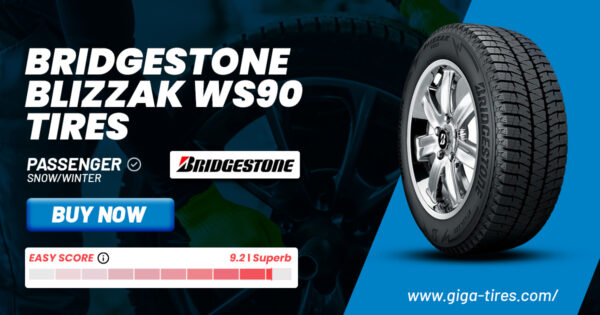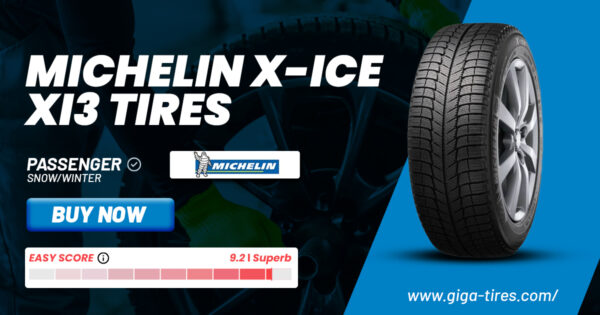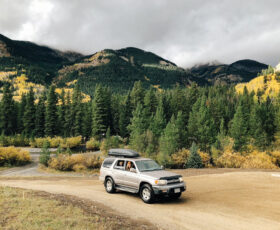Last Updated on 4 months
Your Comprehensive Guide to Snow Tires for Confident Winter Driving
As winter approaches, drivers often face the challenge of navigating cold, snowy, and icy roads. The key to maintaining control and safety in these conditions lies in having the right set of tires. Snow tires, also known as winter tires, are designed to provide enhanced traction, improved handling, and reliable performance on treacherous roads. This guide will introduce you to the numerous benefits of snow tires and offer valuable tips on selecting, installing, and maintaining the best ones for your vehicle.
Key Takeaways:
- Understand the importance of snow tires for winter safety and performance.
- Discover the unique features of snow tires, including tread patterns and cold-resistant rubber compounds.
- Learn about the optimal time to install snow tires to ensure maximum safety and efficiency during winter.
- Explore the differences between studded and studless snow tires and performance winter tires for high-performance vehicles.
- Get familiar with state-specific regulations on snow tire usage and potential insurance discounts.
- Gain insights on how to maintain snow tires for sustained performance and longevity.
- Equip your vehicle with the most suitable snow tires, prioritizing safety and meeting regional legal requirements.
Understanding Snow Tires and Their Importance
Snow tires, specifically designed for winter conditions, provide indispensable safety benefits by offering superior traction and handling. These tires are critical in maintaining vehicle control and performance during cold, snowy months. Snow tires’ snow-specific tread and cold-resistant rubber compounds significantly improve safety, reducing the risk of accidents. Beyond personal safety, some areas require snow tires by law during the winter months, and insurers may provide discounts recognizing their safety advantages.
When Understanding Snow Tires, it is crucial to grasp the major differences between snow tires (known as winter tires) and all-season tires. Although all-season tires are designed to accommodate a variety of road conditions, they do not possess the unique features that give snow tires a clear advantage during the extreme winter months.
The right snow tires can improve winter driving safety and performance by ensuring optimal traction.
Let’s examine some of the critical reasons behind the Importance of Winter Tires and how they contribute to your on-road Safety with Snow Tires:
- Superior traction and handling on icy roads
- Better performance in freezing temperatures
- Shorter braking distances
| Snow Tires | All-Season Tires |
|---|---|
| Designed specifically for cold, snowy, and icy conditions | Designed to handle various situations, but not as effective in extreme winter weather |
| Specialized tread patterns and rubber compounds for improved traction | General tread patterns and combinations lacking the same cold-resistant capabilities |
| Shorter stopping distances on snowy and icy roads | Longer stopping distances in the same conditions |
| It may be legally required in certain regions for winter driving | There are no legal requirements specifically for winter road conditions |
In conclusion, understanding the differences between snow tires and all-season tires and the importance of equipping your vehicle with proper winter tires can significantly impact your vehicle’s performance, safety, and even the potential for insurance discounts during the cold and snowy months.
The Distinct Features of Snow Tires
Snow tires are uniquely designed to enhance driver safety and vehicle performance in cold and snowy conditions. These features include specialized tread patterns, advanced rubber compounds, and optimal tread depth, enabling significantly improved winter traction, handling, and stability. Let’s explore each aspect in more detail to understand these features and their importance better.
The Role of Tread Patterns in Winter Traction
Snow tires are meticulously crafted with deep grooves and multiple bite-sized sipes, increasing sipe density to grip snow and ice effectively. This complex design improves winter traction, handling, and stability on treacherous roads. When comparing Enhanced Traction Snow Tires to regular tires, the difference in pattern is evident, offering superior grip and stability in snow-covered environments.
Advances in Rubber Compounds for Flexibility
Snow tires incorporate advanced rubber compounds that maintain flexibility in cold temperatures, contrasting with all-season tires that harden and lose traction. This flexibility is the backbone of winter tire performance, aiding in road grip and responsive handling. In addition, snow tires outshine their all-season counterparts by providing better performance than flexible winter tires, ensuring they remain resilient in various cold weather conditions.
Importance of Tread Depth in Snow Performance
Optimal snow tire performance relies heavily on appropriate tread depth. Deeper treads are essential for maintaining traction in deep snow, channeling slush away, and preventing snowy build-up, which is crucial for winter driving in regions with significant snowfall. By focusing on Tread Depth Importance, Deep Tread Winter Tires provide enhanced safety, control, and stability when traveling in snow.
- Winter Traction: Tread patterns designed for maximum grip on snow and ice
- Rubber Compounds: Formulations tailored to remain flexible in frigid temperatures
- Tread Depth: Deeper than all-season tires for better snow performance
Snow tires showcase superior safety and performance capabilities in winter driving conditions, thanks to their unique tread patterns, advanced rubber compounds, and optimal tread depths.
In conclusion, snow tires offer a crucial advantage in winter driving conditions, marked by their specialized tread patterns, innovative rubber compounds, and optimized tread depths. These comprehensive features contribute to maximum snow handling, excellent functionality, and enhanced performance on cold and challenging roads.
When to Install Snow Tires for Optimal Safety
Optimal snow tire installation is critical for ensuring road safety during the winter months. The ideal time for snow tire installation is when temperatures consistently drop below 45°F, commonly occurring in late fall before the peak of winter. Being mindful of seasonal changes and adhering to the best time for snow tires is essential, as timely installation correlates with the onset of hazardous snowy and icy road conditions, ensuring maximum safety and tire efficiency.
It is important to monitor weather forecasts and pay attention to average temperatures in the area. This helps identify the most suitable moment for snow tire installation and contributes to optimal safety with snow tires during winter. Preparation is key to guaranteeing your vehicle is well-equipped for the harsh winter roads.
It’s not just about having snow tires, but knowing when to install them is equally crucial for ensuring road safety during winter.
Here are a few factors to keep in mind when deciding on the optimal snow tires installation time:
- Monitor average temperature and forecasts
- Consult your vehicle’s owner manual for manufacturer-specific guidelines
- Consider regional legal requirements for snow tires
- Plan for potential delays at tire installation centers
As winter approaches, tire installation centers can become crowded and backed up due to increased demand. It is advisable to begin preparations beforehand to avoid last-minute rush and delayed installations.
Beyond timely installation, proper maintenance and storage during off-seasons can help prolong the life and performance of your snow tires, ultimately offering safer driving during the ensuing winter seasons.
Essential Considerations: Studded vs. Studless Snow Tires
When considering snow tires, the choice between studded and studless options is based on regional winter severity and local regulations. Each type of tire offers unique advantages and disadvantages that must be considered when selecting.
Studded tires offer exceptional ice traction but may damage road surfaces and are noisy, while studless tires provide substantial grip and performance in snowy conditions without the potential for road harm.
- Studded Snow Tires – These tires are equipped with metal studs embedded in the tread, providing enhanced traction on icy roads. Studded tires are best suited for areas with severe winters characterized by numerous icy roads and prolonged snowfall. However, they may be restricted or prohibited in some regions due to potential road damage and increased tire noise.
- Studless Winter Tires – With no metal studs, these tires rely on innovative rubber compounds and advanced tread patterns to offer impressive grip in snowy and icy conditions. Studless winter tires deliver a quieter ride and prevent road damage, making them a more versatile option for many drivers.
To further understand the differences between studded and studless snow tires, consider the following table:
| Feature | Studded Snow Tires | Studless Winter Tires |
|---|---|---|
| Traction on Ice | Excellent | Very Good |
| Traction on Snow | Good | Very Good |
| Noise Level | Noisy | Quiet |
| Road Damage | Potential for Damage | Minimal to No Damage |
| Regional Restrictions | Restricted or Prohibited in Some Regions | Unrestricted |
Performance winter tires cater to high-performance vehicles seeking winter traction with maintained agility. These tires provide enhanced grip and handling in cold weather without sacrificing the high-performance models’ responsiveness and sporty nature.
In conclusion, deciding between studded and studless snow tires depends on your specific driving needs, regional weather severity, and potential legal restrictions. Carefully evaluate your requirements and prioritize safety when selecting the best snow tire option for your vehicle.
Maximizing Vehicle Safety with Winter Tires
Winter tires are specifically engineered to improve vehicle safety in adverse winter conditions. Utilizing Enhanced Traction Winter Tires can significantly reduce the risk of accidents during the colder months. Winter tires are pivotal in ensuring drivers’ safety by providing better traction and control on slippery surfaces. Let’s delve into the benefits of these specialized tires, including their impact on stopping distances and potential collision avoidance.
Benefits of Enhanced Traction and Control
Vehicle Safety Snow Tires enable consistent contact with the road throughout winter’s challenging conditions. As a result, drivers maintain better control and stability, making maneuvering through snowy and icy roads much safer. Moreover, the increased traction these tires provide decreases the likelihood of skidding or sliding on treacherous surfaces.
Winter tires with enhanced traction can make the difference between a safe winter driving experience and a potentially dangerous situation on icy roads.
Shorter Stopping Distances and Collision Avoidance
One key safety benefit of using winter tires is the considerable reduction in stopping distances on snowy and icy roads. Consider the following table, which highlights the average difference in stopping distances between standard all-season and winter tires:
| All-Season Tires | Winter Tires | Difference |
|---|---|---|
| 150 feet | 115 feet | 35 feet |
As illustrated, winter tires can reduce stopping distances by up to 35 feet on average. This critical safety advantage can allow drivers to avoid potential collisions and make sudden stops when necessary. Accidents caused by unsafe braking on snow tires can be minimized, making these specialized tires an indispensable asset for winter driving.
In conclusion, investing in Enhanced Traction Winter Tires is wise for those seeking a safer driving experience throughout the winter months. These tires can significantly reduce the risks of driving on icy and slippery roads by offering better control, shorter stopping distances, and improved collision avoidance. Always prioritize safety and take precautions to guarantee a secure and comfortable winter journey.
Differentiating Snow Tires from All-Season Tires
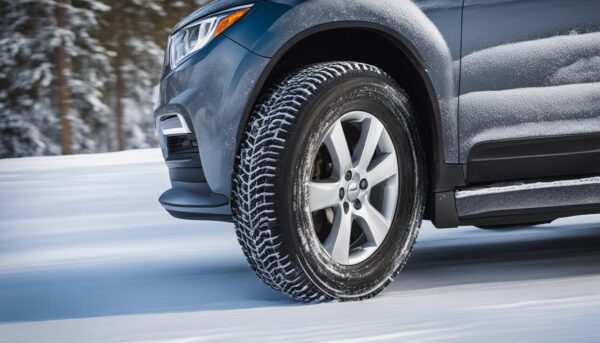
When selecting the perfect tires for your vehicle, understanding the key differences between snow and all-season tires is crucial. Both tires are designed to address distinct weather conditions and road surfaces, so making an informed decision based on your driving needs and geographical location is essential.
While snow tires offer superior traction and handling in icy or snowy environments, all-season tires are intended to provide adequate, year-round performance in a variety of conditions. Consequently, snow tires emerge as the safer option when harsh winter weather is expected.
Here are some key differences to help you differentiate between snow tires and all-season tires:
- Tread Design: Snow tires have specialized tread patterns with deep grooves and sipes, improving grip and traction on ice and packed snow. In contrast, all-season tires have less aggressive tread patterns that focus on providing decent grip in mild weather conditions.
- Rubber Compound: Winter tires’ advanced cold-resistant rubber compounds help them maintain flexibility at extremely low temperatures. Conversely, all-season tires are made of material that hardens in extreme cold, consequently losing traction.
- Performance: Snow tires deliver higher traction and stability on icy roads and heavy snowfall. All-season tires are best suited to moderate climates without extreme temperature fluctuations and offer functional performance throughout the year.
| Features | Snow Tires | All-Season Tires |
|---|---|---|
| Tread Design | Deep grooves, dense sipes, | Mildly aggressive |
| Rubber Compound | Cold-resistant | Standard |
| Performance | Winter-focused (/cold, snowy, icy roads) | Year-round (moderate climates) |
In conclusion, snow tires vs all-season tires is not a one-size-fits-all comparison. Instead, your final choice should be determined by your region’s driving conditions and climate. Generally, if you experience harsh winter weather and prolonged periods of snow or ice, investing in snow tires is the right call to ensure maximum safety and vehicle performance.
Navigating the Market: Snow Tires for Sale
With the snow tire market offering diverse options from brands like Pirelli, Michelin, and Bridgestone, vetting reviews is critical to making an informed purchase. These reviews help customers understand their performance in real-world winter conditions, ensuring they choose the appropriate snow tires for their needs and driving habits.
Vetting Snow Tires Reviews for Best Selections
With many snow tires for sale, consumers must research and compare various options to select the best ones for their vehicles. Snow tire reviews can offer valuable insights into the performance and longevity of different tire brands and models, but it is essential to find reliable sources for these reviews.
Expert tips for choosing snow tires:
– Prioritize traction and handling capabilities for your driving conditions.
– Consider your budget without sacrificing safety and performance.
– Verify compatibility with your vehicle make and model.
– Assess local legal regulations and guidelines for winter tire requirements.
Aside from professional reviews, it’s beneficial to seek trusted advice from friends, family, or acquaintances who have experience driving with snow tires in similar conditions. Additionally, some popular snow tire options include:
Pirelli Winter Sottozero 3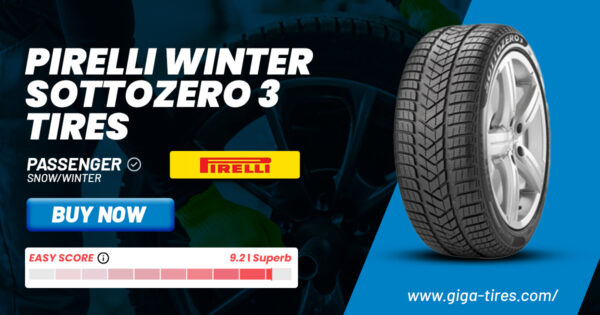 When comparing tire options, it’s essential to consider factors like tread depth, rubber compounds, and overall performance in a range of winter conditions. The following table demonstrates key considerations when selecting snow tires:
When comparing tire options, it’s essential to consider factors like tread depth, rubber compounds, and overall performance in a range of winter conditions. The following table demonstrates key considerations when selecting snow tires:
| Consideration | Explanation |
|---|---|
| Tread Pattern | Look for snow tires with aggressive tread patterns designed to channel snow, slush, and water away from the contact patch. |
| Rubber Compounds | Ensure the tire compounds are formulated for optimal grip and flexibility in cold temperatures, typically below 45°F. |
| Studded vs. Studless | Research local laws and personal preferences to determine whether to opt for studded or studless snow tires, considering both traction and road safety concerns. |
| Load Index and Speed Rating | Verify the snow tires match or exceed your vehicle’s specifications for load-carrying capacity and maximum rated speed. |
Considering these considerations will help you navigate the market and effectively select the ideal snow tires for sale to meet your particular requirements and enhance your winter driving safety.
Winter Tires and Legal Considerations Across States

As winter approaches and road conditions worsen, it becomes imperative for drivers to be aware of state-specific regulations regarding the use of snow tires. Each state has its legislation, and knowing the requirements can save you from fines or penalties while ensuring you’re driving safely and following the legal expectations. In this section, we will look closely at some state regulations for winter tires and their impact on drivers in various parts of the country.
| State | Regulation | Key Considerations |
|---|---|---|
| California | Chain Control Requirement | Drivers may be required to install traction devices, such as chains, on their tires to drive in certain mountainous areas during winter. |
| Colorado | Code 15 on the I-70 Corridor | Drivers must use snow tires, tires with an M+S (mud and snow) rating, or have chains on hand when driving between September 1 and May 31 on the entire I-70 mountain corridor. |
| Oregon | Chain Control Requirement | The state may require chains or traction tires, such as snow tires, on certain roads during winter weather. |
| New York | Studded Tires | Studded snow tires are allowed from October 16 to April 30. |
| Washington | Chain Control Requirement | Some state highways may require winter tires, studded tires, or tire chains during winter weather events. |
Regardless of the state, it is always wise to check the latest regulations and prepare your vehicle to meet your region’s specific winter tire requirements. This will not only ensure legal compliance but will also improve your driving safety. In some cases, insurance companies may even offer discounts for drivers who use winter tires, recognizing their benefits in reducing accidents on icy and snowy roads.
If you’re unsure whether your tires meet the standards set by your state, consult your vehicle’s owner manual or consult a professional tire dealer. They can provide expert advice on winter tires and help you make an informed decision based on your vehicle, local regulations, and driving conditions.
Maintaining Snow Tires for Sustained Performance
Consistent snow tire maintenance is crucial for achieving sustained performance in winter tires. Extending their service well into many winter seasons. Proper snow tire care ensures optimal grip on snowy, icy roads, ultimately maintaining the safety and performance benefits associated with winter tires. Here are some key maintenance pointers and considerations:
- Proper mounting and balancing
- Periodic inspection for wear and tear
- Checking tread depth regularly
- Meeting load index and speed rating specifications recommended by the manufacturer
Optimal snow tire performance and longevity largely depend on proper maintenance.
Correct mounting is paramount, as improperly mounted tires can lead to uneven wear, vibration, and increased tire noise. Furthermore, unbalanced tires will likely result in irregular wear patterns, adversely affecting tire performance and safety.
Take note of the tread wear, as excessive or uneven wear may signal the need for a professional alignment or indicate internal tire damage. To stay ahead of potential problems and preserve the longevity of your snow tires, have them inspected by a certified professional at least once a season.
Periodically verifying the tread depth of your snow tires is of significant importance. Adequate tread depth is essential for maintaining traction and directly influences your vehicle’s safety on snowy and icy roads. The minimum tread depth for winter tires is usually 6/32 inches.
| Maintenance Task | Tools Needed | Frequency |
|---|---|---|
| Inspect tires for wear and tear | None | Monthly |
| Check tread depth | Tread depth gauge | Monthly |
| Mount and balance tires | Professional assistance | Annually |
| Rotate snow tires | Professional assistance | As per the manufacturer’s recommendation |
In addition to these essential maintenance tasks, ensure that your snow tires match the manufacturer’s recommended load index and speed rating specifications. These specifications are designed to maintain tire safety and performance while upholding the vehicle’s capabilities.
Lastly, consider storing your winter tires correctly during the off-season to prevent damage and maintain longevity. Proper storage includes keeping them away from direct sunlight, heat, and humidity, ensuring they are ready for use when the next winter season comes around.
Conclusion
Equipping your vehicle with snow tires becomes a crucial safety consideration as winter approaches. Thorough planning and installing appropriate winter tires provide drivers with invaluable benefits, such as improved traction, more responsive handling, and shorter braking distances. Consequently, investing in snow tires will enhance your driving experience and safety on the road during the colder months.
Beyond personal safety advantages, having snow tires also allows drivers to adhere to regional laws and regulations, which, in some areas, mandate the use of these specialized tires during the winter season. Compliance with these requirements ensures vehicles are prepared to handle adverse road conditions and weather challenges without compromising safety. Additionally, it can help you avoid potential fines resulting from non-compliance.
In conclusion, snow tires ensure safety and control during winter driving. By taking the time to research and invest in the right winter tires for your vehicle, you’ll be making a cost-effective, responsible decision that aligns with your needs and legal requirements. Don’t forget to employ snow tire safety tips such as proper maintenance and timely installation to guarantee a secure and well-prepared journey throughout the winter season.
FAQ
What are the main benefits of using snow tires over all-season tires?
Snow tires provide enhanced traction, improved handling, and shorter stopping distances in winter conditions compared to all-season tires. They are specifically designed for colder temperatures, with specialized tread patterns and rubber compounds that maintain flexibility in freezing temperatures.
When should I install snow tires on my vehicle?
It is recommended that snow tires be installed when temperatures consistently fall below 45°F, typically during late fall, and that they be changed back to regular tires in the spring. Timely installation is crucial for ensuring maximum safety and efficiency of snow tires during the winter months.
What are the main differences between studded and studless snow tires?
Studded snow tires have metal studs embedded in the tread, offering exceptional traction on ice, but they can damage road surfaces and generate more noise during driving. Studless tires provide adequate grip and performance in snowy conditions without causing road damage or increased noise levels.
How can I choose the best snow tire for my vehicle?
Research brands like Pirelli, Michelin, and Bridgestone, and read snow tire reviews to understand their performance in real-world winter conditions. Consider your driving habits, regional winter severity, and local regulations before choosing the best snow tire.
Are there any legal considerations regarding snow tire usage?
Some states with harsh winter conditions mandate the use of snow tires during specific months, and penalties may apply for non-compliant drivers. Always check state-specific laws and regulations when considering snow tire usage.
How do I maintain my snow tires for optimal performance and longevity?
Proper maintenance of snow tires includes regular tread depth checks, ensuring they meet the load index and speed rating specifications, and correct mounting and balancing. Periodic inspections for wear and tear should also be conducted to prolong the life of both winter and regular tires.
Source Links
- https://www.tires-easy.com/blog/snow-tires-guide/
- https://www.tires-easy.com/blog/mastering-winter-with-snow-tires/




